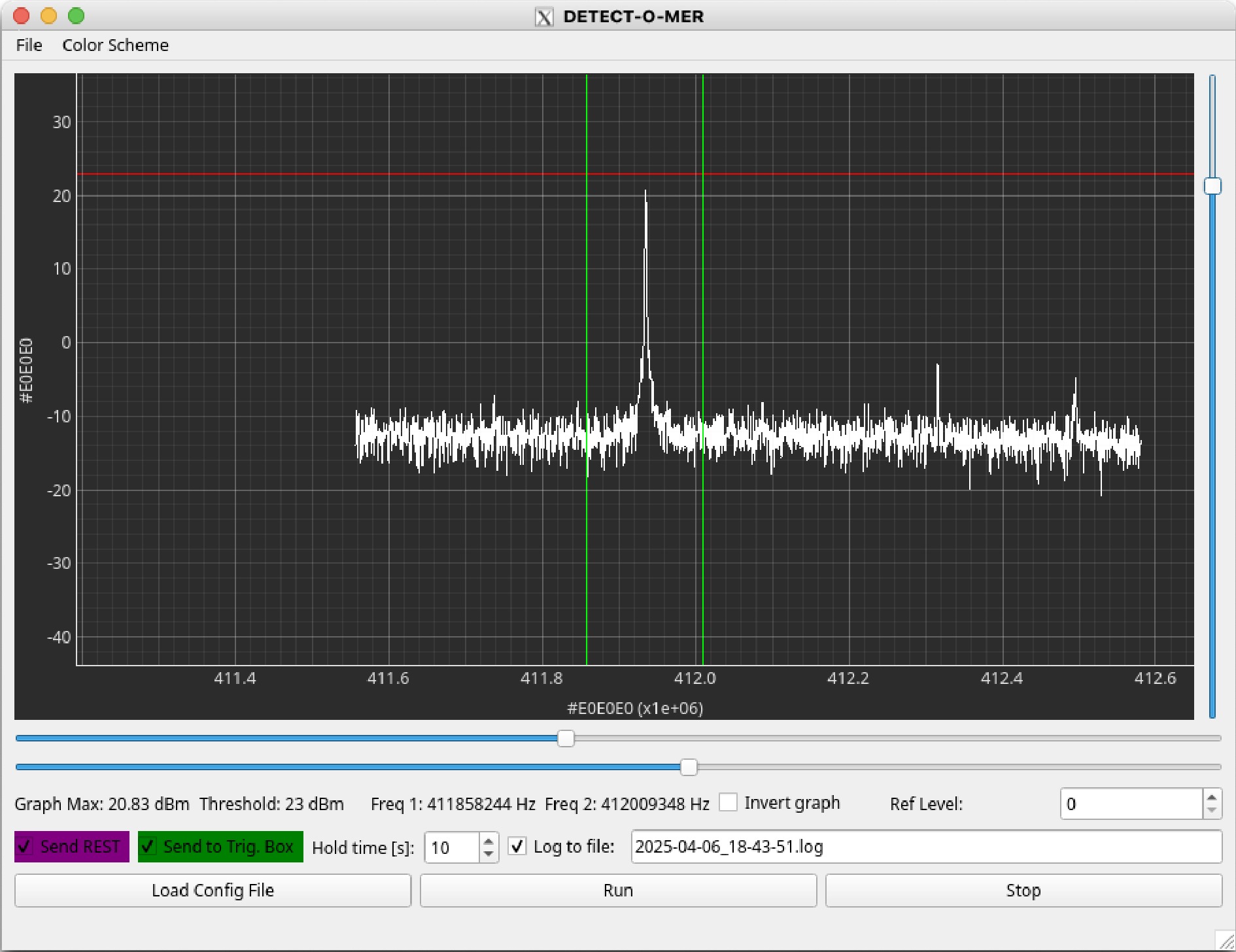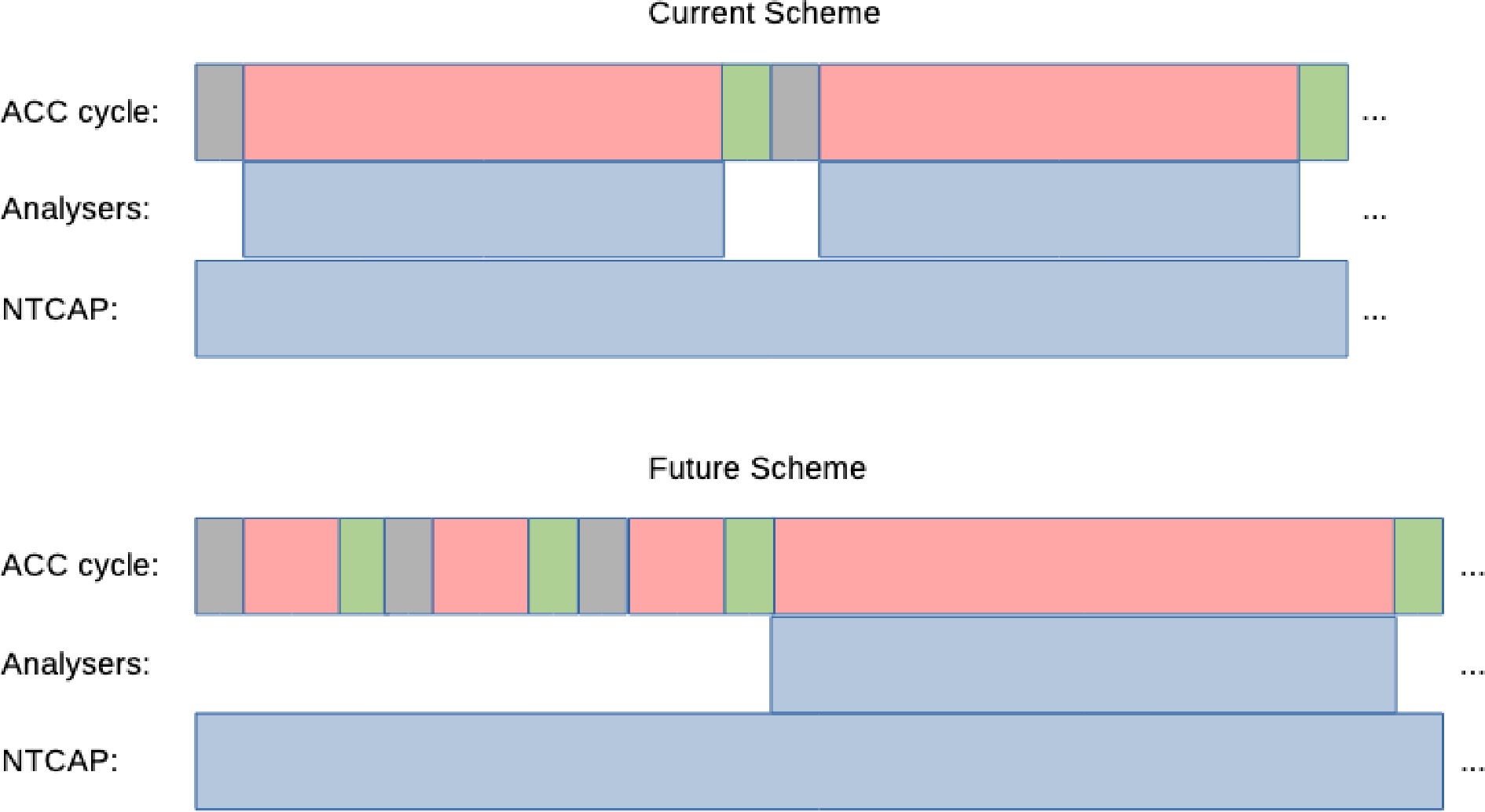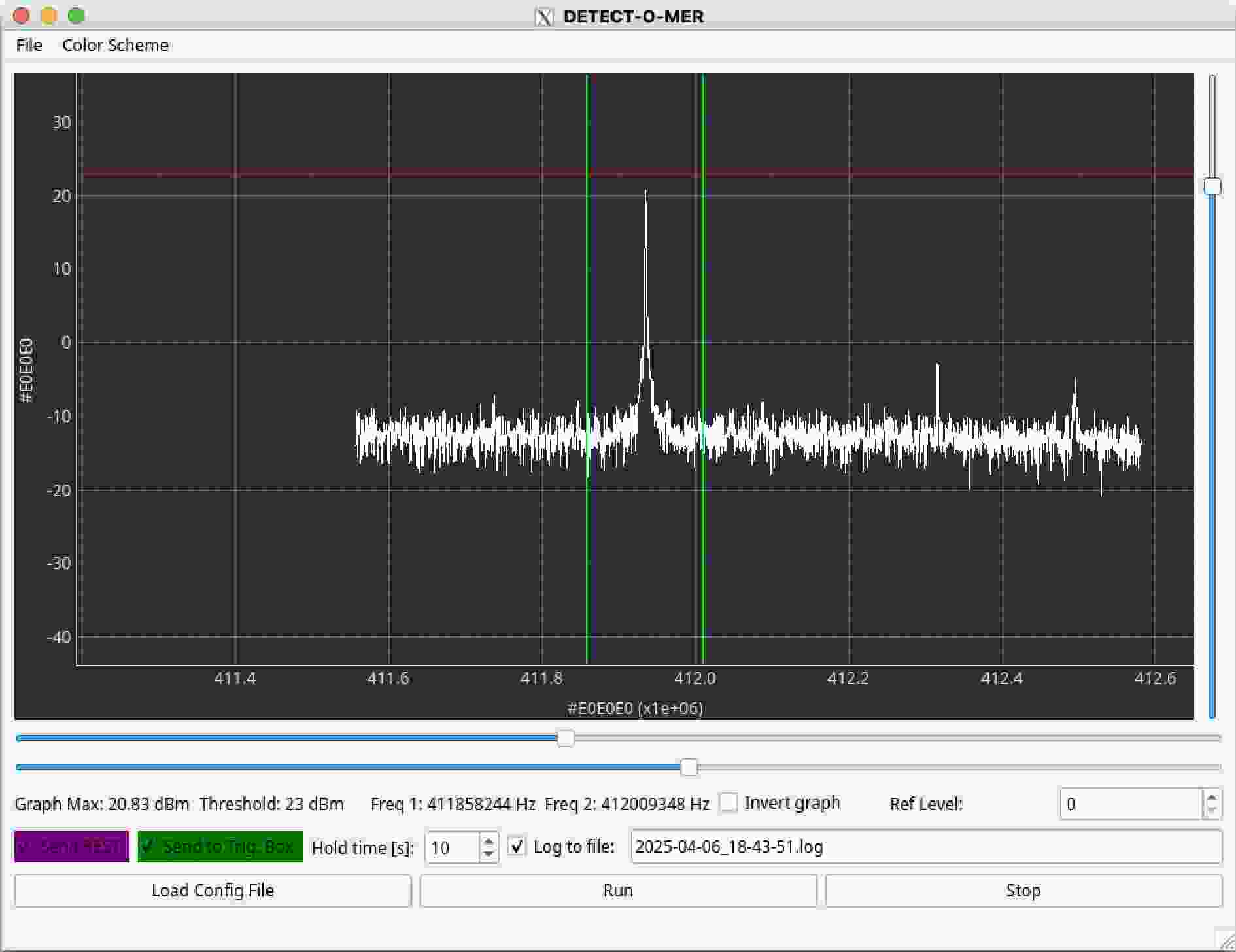-
Non-destructive detection methods are often used for in-flight measurements of beam properties based on frequency analysis. In addition to typical applications in accelerator physics to acquire beam parameters such as intensity and revolution frequency, non-destructive Schottky detectors are routinely utilized as major detection systems in precision physics experiments [1]. Remarkable examples are mass and lifetime measurements of exotic nuclei in ion storage rings [2−5]. Measurements of lifetimes as long as
$ \approx $ 300 days [6, 7] and as short as tens of milliseconds have been possible in the Experimental Storage Ring (ESR) [8, 9].Current research is focused on addressing exotic nuclides lying at the outskirts of the nuclidic chart. These nuclides are inevitably short-lived and are produced with vanishingly small rates, which makes studying them very difficult. Therefore, for maximum scientific output, the measurements are conducted in a loop in which the production of fresh ions and their investigation are performed as frequently as possible. This routine is implemented into the accelerator control system that runs continuously with a predetermined repetition cycle. However, in some scenarios, a very rare particle of interest is long-lived, which means that the accelerator sequence must be abruptly halted to determine its lifetime.
A particular physics case is the search for rare long-lived isomeric states. Isomers in neutron-rich nuclei in the
$ A=180 $ region were studied previously in the ESR, where among others, new isomers in$ ^{184} $ Hf and$ ^{186} $ Hf were discovered [10, 11]. To measure the corresponding half-lives, the research team manually observed spectra and stopped the accelerator. Such a procedure can only be performed at a repetition time of several minutes. However, human errors are likely to occur. The next objective is to search for even more exotic isomers in$ ^{188} $ Hf, which requires a change in the procedure.In this paper, we report on the application of software defined radio (SDR) in on-line interactions with the beam processes of the ESR heavy ion storage ring. We discuss how this new technique can enhance the beam time efficiency and create new measurement possibilities.
-
Resonant Schottky cavity detectors for frequency and intensity measurements, which are often termed "longitudinally sensitive," have been installed in the ESR heavy ion storage ring at GSI Darmstadt [12−14], CSRe storage ring at IMP Lanzhou [15, 16], and Rare RI-Ring (R3) storage ring at RIKEN [17, 18]. In the latter storage ring, recent efforts have focused on designing position sensitive ("transversely sensitive") Schottky cavity doublet detectors [19−24].
Schottky signals consist of broadband high frequency components [25]. These place high demands on the data acquisition hardware in terms of acquisition bandwidth and dynamic range. Commercially available spectrum analyzers have proved very useful for various stages of experimental preparation and signal acquisition; however, for long-term recording of the signal, a continuous time acquisition system is required. For the ESR, originally, the time capture (TCAP) system was designed [26], which was followed by an upgraded new time capture system (NTCAP) [27].
-
One of the major limitations of the previous time recording systems at GSI is the high initial cost of individual modules, vendor lock, and closed source operating software, which also lacks long-term commercial support. This affects the reliability of these data acquisition systems and hinders their use in distributed scenarios due to lack of scalability.
In contrast, SDR represents a paradigm shift in the data acquisition of radio frequency signals by using software to process and manipulate signals, a task that has traditionally been handled by or hard-coded into specific hardware components. SDRs facilitate advanced signal processing techniques and enable rapid prototyping and experimentation in communications systems. They are available on the market in various sizes and prices, making them suitable candidates for both redundant and distributed data acquisition nodes.
Common to most popular SDR systems is the open source driver stack and, to some extent, open access hardware, making the acquisition and analysis code easily maintainable. The acquisition software itself can be published according to open science standards and Findable, Accessible, Interoperable and Reproducible (FAIR) [28] principles, together with other components of research, such as raw, intermediate, and result data, as well as the data analysis software.
The relevance of SDRs has already been recognized for the control system of GSI and the future FAIR project, for monitoring and acquiring slow and fast analog signals as well as signals from different RF sources. Current versions of the GNU-Radio are now being partly developed at GSI [29].
SDRs can also be used as alternative time capture systems for Schottky detector systems for physics research in storage rings. Some progress has been made in this aspect (see, for example, [30] or the sdrTcap project [31]). However, the versatility of SDRs enables their use in even more sophisticated applications in on-line monitoring and processing of acquired data.
-
The new GSI control system enables interaction with ESR parameters and beam processes via a well-defined REST interface. Hence, specific blocks (also known as virtual accelerators) with unique identifiers are introduced within beam patterns. Among the many features associated with these blocks is the ability to set a breakpoint. This would then hold the pattern, pausing the entire injection cycle. This breakpoint can be set and released manually by pressing a button on the control system GUI or by sending a message to the control system via the REST interface [32].
A new code was developed to utilize this feature to create a conditional breakpoint based on the spectral power of the RF signal from the Schottky detectors [33]. This code consists of two parts to enable modularity and scalability for future applications.
The data sampler part has a command line interface (CLI). It acquires samples from a Realtek (RTL) SDR device according to settings in a configuration file and makes the data available on the local network as a publisher using the ZeroMQ messaging library. In this work, a NESDR SMArt v5 with larger temperature stability was used, although alternative RTL-SDR devices can also be used.
The graphical user interface (GUI) part (see Fig. 1) subscribes to the data of the ZeroMQ channel on the local network and displays its Fourier spectra in real time. Zoom functions and sliders can be used to select a region where a desired peak may appear, in which case a REST signal is generated and sent to set a breakpoint on the beam pattern in the same beam cycle. The user can set the release time via the GUI, after which the breakpoint is reset and the beam process restarts the cycles. The GUI also enables independent logging of the exact timestamps of each event.

Figure 1. (color online) GUI interface of the code "detectomer" [33] for monitoring the appearance of a signal of interest: testing the trigger on the 214th harmonic of some randomly stored fragments at 364.9 MeV/u in the ESR.
Previously, lifetime measurements were performed in the standard mode of operation within the ESR at fixed time intervals. For example, for a two-body decay of
$ ^{142} $ Pm, the aim was to store only a few ions at a time. Here, the beam pattern was set to a fixed delay of approximately 64 s before a new injection was prepared. This time was calculated to be slightly longer than the estimated lifetime of approximately 42 s. Each injection, including inevitable the empty ones was saved to a separate file using the spectrum analyzers while the NTCAP system was running continuously in the background [8]. Shorter lifetimes were measured in the isochronous mode of the ESR with much shorter cycles on the order of 10 s and below, in search for lifetimes on the order of milliseconds. Again, single shot acquisition was complemented by the NTCAP system running in the background [9].Common to the above measurements are the relatively short lifetimes of the species of interest and high yield, i.e., production cross section. However, for species of interest with very long estimated lifetimes and very low yields, fixed duration patterns significantly reduce the efficiency of the beam time.
Figure 2 shows schematically how the new system can significantly improve beam time efficiency by continuously monitoring the beam inside the ESR. If the rare species of interest (e.g., a long-lived isomer) appears during the injection, it is detected and a breakpoint signal is sent to the accelerator control system. This prevents a new injection and prolongs the current beam cycle by a pre-defined time, that is set in the GUI. Otherwise, a new injection is prepared within a couple of seconds.

Figure 2. (color online) Schematic of the previous timing techniques compared with the technique suggested in this study. Gray and green boxes show accelerator cycle start (injection) and end, red boxes show accelerator waiting time, and blue boxes show recording time using the triggered spectrum analyzers and the continuously running NTCAP.
In the previous scheme, the spectrum analyzers would produce recording files of equal size. The analysis procedure was responsible for detecting whether files contained an event. Additionally, the continuous stream of NTCAP data had to be chopped into individual segments or files using offline algorithms to detect the injection times. A separate code has been developed for this [34].
In contrast, in the new scheme, a breakpoint is set on the accelerator pattern immediately after an event is detected, and with each breakpoint, a timestamp entry precisely documents the location of that event in the NTCAP stream. Moreover, the spectrum analyzers will be triggered on that condition, ensuring that every recorded injection contains an event. The spectrum analyzers are triggered using a network based distributed trigger system that was developed for these purposes [35]. The network latency is very short but does not play a major role owing to the trigger offset feature of the spectrum analyzers, enabling them to continuously monitor the signal using a moving time window.
-
Schottky cavity-based detectors are fast and sensitive devices that can be used for mass and lifetime measurements of exotic isotopes and their isomers. Open source data acquisition systems based on SDR complement the operation of Schottky detectors and contribute to the scalability of data handling.
Using SDR, a new code permits, for the first time, online interaction with the accelerator beam processes and decision making during the same cycle. The suggested configuration enables addressing the measurement of unstable nuclide and isomer states, which are long-lived than the cycling time but have a very low yield, thus increasing the efficiency of the beam time.
While the above code does not use the GNU-Radio library, we envisage that this library can be used to build even more complex and versatile conditional systems using the combination of online beam monitoring using SDRs and coupling to accelerator parameters. The use of customized GNU-Radio library blocks would also enable connection to other GSI and FAIR infrastructure. A recent implementation now enables usage of FAIR timing system as a GNU-Radio block [36], which allows for precise data acquisition and synchronisation using unique time stamps.
Finally, because RTL-SDRs have a limited sampling rate, we hope to move toward SDRs with higher sampling rates and multiple inputs, such as those from Lime Microsystems [37]. Again, the GNU-Radio library would play a very important role here.
Software defined radio for on-line interaction with beam processes in the heavy ion storage ring ESR
- Received Date: 2025-03-27
- Available Online: 2025-07-15
Abstract: The application of software defined radio in on-line interactions with the beam processes of the heavy ion storage ring is presented. We discusse how this new technique can enhance the beam time efficiency and create new measurement possibilities. A specific example to halt the accelerator running if a rare stored particle is identified on-line is discussed.





 Abstract
Abstract HTML
HTML Reference
Reference Related
Related PDF
PDF















 DownLoad:
DownLoad: